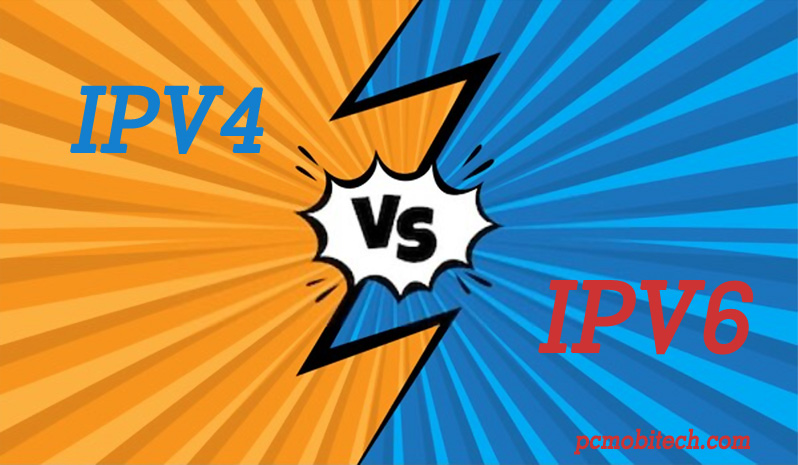Any machine connected on a particular network gets its identification through IP address. You can understand IP or internet protocol as a numerical label given to each of the devices that are connected to a network and using IP for communication.

Quick Links
What is The Difference Between IPV4 and IPV6?
As discussed above, IPs or Internet Protocols are provided to each device during connection, as it is a technical format that is used for networking. – And IPV4 and IPV6 are actually two different versions of IP- Internet Protocol Version 4 and Internet Protocol Version 5.
IPv4 is the version of the Internet Protocol that supports manual and DHCP address configuration. It has an address length of 32-bit, and the security feature is a bit dependent on the applications.
It’s challenging to achieve end-to-end connection in IPv4, and the address representation of this is in decimal. It generates 4.29×109 address space, and in this, the identification of packet flow isn’t available. It has a header of 20-60 bytes and has a Broadcast message transmission scheme.
Meanwhile, IPv6 is the newest version of Internet Protocol and has an address length of 128-bit. The address representation in this IP version is in hexadecimal.
Also, in the IPv6, authentication and encryption are available with a header of 40-bytes. The address space here is 3.4×1038, which means it is quite more extensive than the former IP version. This version supports remembering address configuration and auto-configuration.
The Internet protocol security (IPSec) for IPv4 is optional, but that of IPv6 is mandatory. In IPv4, the clients have to approach DHCS, but they don’t have to do so when they’re using IPv6. For IO to MAC resolution, the initial one requires Broadcast ARP, but the later one needs Multicast Neighbour Solicitation.
History

1. IPv4
IPv4 is the 4th version of Internet Protocol, and it uses 32 bits for the Internet addresses. A unique and numeric IP address is assigned to every device whenever any device is connected with the Internet. For sending data from one system to another system through the Internet, the data is transferred in both the devices. And IP addresses are crucial for every computer since it won’t be able to send data or communicate without it.
IPv4 is one of the widely used Internet Protocol when people want to connect with the Internet. This protocol version allows a total of 2×32 addresses; therefore, it has enormous growth and uses all over the world.
2. IPv6
The latest version of Internet Protocol is IPv6, and this version came into existence for fulfilling the need for more Internet addresses. Also, we can say that IPv6 was launched to resolve the problems faced by the usage of IPv4.
It allows 340 unique address space with 128-bit, and it is also known as the Internet Protocol next generation. We can say that this version of protocol came as the support for Quality of services.
The number of header files that this version of Internet Protocol gives us is 8, and the length of the header field is 40. While talking about Checksum fields, it doesn’t have it, and the types of the address present in it are Multicast, Anycast, and Unicast.
You May Also Like:
- Difference Between Static and Dynamic IP
- What Does WiFi Stand For? (What is WiFi?)
- 3 Easy ways to share files, folders & drives in VirtualBox.
- How to Block an App from Accessing the Internet Android?
Benefits of IPV4 and IPV6
Advantages of IPv4
- This Internet Protocol is connectionless.
- This version offers several video conferences and libraries.
- It is easy to remember addresses and requires less memory.
- Millions of networking devices support it.
Advantages of IPv6
- Routing infrastructure and hierarchical addressing are there in this version.
- For the interaction of neighboring nodes, this is the best protocol.
- The stateless and stateful configuration is present.
- Quality of Services has been supported.
How Do These Work

1) Working of IPV4
IPv4 works with TCP/IP protocol stack by networking layer. The ultimate task of this Internet Protocol is of transferring data from the sender to the destination (receiver) point. The unique identification of protocol is made whenever there is any transfer of data
2) Working of IPV6
IPv6 is used for data transfer and communication between networks. This version was launched in 1998 and existed with the sole purpose to replace the IPv4. IPv6 has three types, Global unicast address, uniquely local and link-local. All of them are address types, and they help in the regulation of IPv6.
Conclusion
IPv4, a binary bit and dots separate it; meanwhile, IPv6 is separated by colons. They are interested in yet opposite of each other. Both of them can exist together on the same network, but they cannot communicate with each other. This is called dual-stack.
Both of them have specific compatibility with mobile devices and work with a different style. Having any doubts about the IPV4 and IPV6? Feel free to ask us in the comments below.
When you purchase through links on our site, we may earn an affiliate commission. Read our Affiliate Policy.




